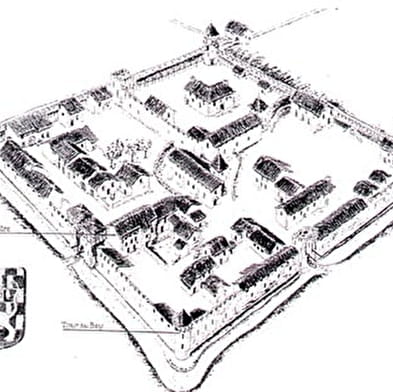
Eglise de Chavannes
The complex underwent numerous modifications, particularly in the 16th and 19th centuries.
History :
Chavannes and Sélignat are the first two villages in the Suran valley to appear in a written document, "the diploma of Lothaire", in 852; this confirms that they are indeed in the possessions of the Abbey of Condat (Saint-Claude). The most plausible origin of the name "Chavannes" is Latin and attests to the existence of huts, thatched cottages on its site.
The existence of a priory (which was later united with that of Coligny in 1275), and of a parish is attested to in 1184 by Frederick I (Barbarossa) emperor of the Holy Roman Empire (2nd of the Hohenstaufen dynasty), but their creation is probably much older. This first parish included the chapel of Lomont as well as that of Arnans, which was then constituted as an independent parish in the 12th century.
This makes it more than likely that Chavannes had its first parish church, certainly in the Romanesque style, as early as the 12th century, and certainly in the 13th century.
In the 11th century, the parishes of the valley came under the authority of the archbishop of Lyon, but the abbey of Saint-Claude retained the right to appoint the parish priest and to collect the tithes. This agreement, acquired not without difficulty, lasted for several centuries. At that time, the parish churches, which succeeded simple chapels, were built according to specific principles: the choir or sanctuary, the consecrated part of the building, accessible only to the clergy, belongs to the ecclesiastical authority in charge (abbey, bishopric) and the decimator (the one who collects the tithe); a sacristy, outside the building but opening onto the choir, can be attached to it (such a sacristy still exists, for example, in the church of Châtillon sur Chalaronne); the nave belongs to the parish; private chapels with an altar and dedicated to one or more saints can either be installed inside the church or be added to the outside of the nave to the south or north, which requires the agreement of the parish so that it can open onto the nave. The construction and maintenance of these different parts are the responsibility of each of the owners and are not necessarily coordinated.
Towards the end of the 10th century, the Sires of Coligny (Manassès in 974) appeared, "lords of the Revermont country", probably successors of the Carolingian counts. Their possessions, known as the "Manche de Coligny", are poorly known but certainly quite vast since they seem to extend to the east of Bresse and as far as the Ain valley, from Orgelet and Saint-Laurent la Roche to the north, as far as the Rhône to the south, if we are to rely on Dubouchet's map dating from the 17th century (1650). It is thus on the territories of the sires of Coligny and under their protection that the priory was established in the 10th and 11th centuries and that the parish of Chavannes was formed.
With the decline of the Lords of Coligny, the Abbey of Gigny was finally placed under the protection of Etienne de Chalon, Count of Burgundy in 1191, a date which marked the arrival of the House of Chalon (more precisely the Chalon-Auxerre branch) in the Suran valley, where it would remain for several centuries. The abbey then ceded its rights over numerous villages and hamlets, including Montfleur, Pont des vents, Saint-Pierre, Pouillat, Laserra and Samonat. Then, in 1251, Jean de Chalon (known as l'Antique), son of Etienne de Chalon, concluded an agreement with the abbot of St-Claude, Hubert de Buenc, ceding the lands of Chavannes to the count in exchange for his protection over the priory. From then on, the limit between the zones of influence of the House of Savoy and the Counts of Burgundy was fixed. For five centuries, it made Chavannes a border town (a border that was not actually marked out until 1612). Finally, it should be pointed out that both the County of Savoy and Franche-Comté, after having been part of the Kingdom of Burgundy (which extended, east of the Saône and the lower course of the Rhône, from the Vosges to Provence) until its disappearance after the death of Rudolf III in 1032, were naturally integrated into the Holy Roman-German Empire (the abbot of Saint-Claude himself had the rank of prince of the empire; The abbot of Saint-Claude himself has the rank of prince of the empire; he also wears the ring and the mitre, which gives him the rank of bishop).
...read more document pdj
- French
- Pets not allowed









